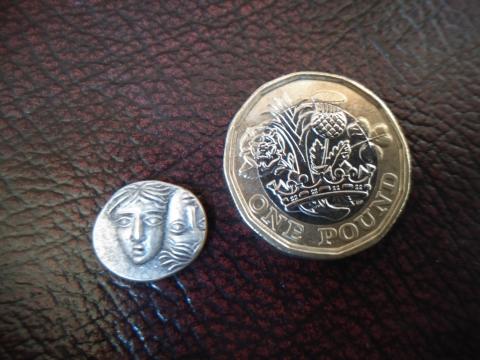A Coin, an Eclipse and the Truest Light

I have in my possession a strange little coin. It is from the ancient Greek colony of Istros, on the Black Sea, which is now part of Romania. It shows an eagle carrying a dolphin, which is likely the pagan god Zeus, but on the obverse is a pair of inverted, identical heads. It was struck between 434 to 300 BC, and is a made of silver. The design is something of a mystery, with Tyler Rossi of Brandeis University helpfully summarising the various explanation in his 2021 article The Mystery of the Double-Headed Coins of Ancient Istros in Coin Week. Explanations vary. The east-west trade routes along the River Danube is one explanation, the heads representing dual wind gods another. They might be the multiple branches of the Ister river, later to be known as the Danube, or the two heads mught represent Kastor and Polydeukes, the mythical Gemini twins. Rossi goes on to cite William Saslaw and Paul Murdin, two
academics at the Cambridge Institute of Astronomy, [who] authored an influential article that argued that the double-headed Istrian coins were actually the earliest commemoration of a solar eclipse in numismatic history. Astronomers are able to predict the date and time of both future and past eclipses to within minutes. After searching for an eclipse that would have been visible from Istros between 450 and 300 BCE, Saslaw and Murdin discovered that at 6:30 am on the fourth of October, 434 BCE, there was a partial eclipse. Initially, the sun would have risen as a crescent with the two points facing up, like a bull’s horns. The sun and moon would have risen at differing speeds, thus as the sun gained altitude the horns would have “flipped” with the horns later facing down. “Clearly the sun god was up to something astonishing.” This would have been “memorable” and “worth recording”. Since “solar eclipses are rare in both space and time,” it would not be unusual for it to be commemorated on a coin.
Other occasions when the sun is obstructed, be that partially or fully, are considered significant in the scriptural record. In Exodus 10:21-23, we are told:
The LORD said to Moses, ‘Stretch out your hand toward the sky so that darkness spreads over Egypt – darkness that can be felt.’
And in Mark 15: 33:
Now when the sixth hour had come, there was darkness over the whole land until the ninth hour.
Likewise, Revelation 6:12 says
“I looked when He opened the sixth seal, and behold, there was a great earthquake; and the sun became black as sackcloth of hair, and the moon became like blood.”
Although fertile minds often ascribe apocalyptic significance to every eclipse, storm and earthquake, the Bible is clear that such events often herald and signify divine judgement. Whether punishing pagan Egypt, the crucified Jesus, or the unbelieving world at time’s end, the sun’s light will be obstructed and darkened. Whatever the inspiration behind those ancient Greeks’ numismatic workings, the light of the sun is but temporal and limited. Better He whose light is eternal and unhindered:
That was the true Light which gives light to every man coming into the world. John 1:9

Bottom image by Dave Davidson from Pixabay
- Log in to post comments


 Sunday Worship 10.45am & 6.00pm
Sunday Worship 10.45am & 6.00pm